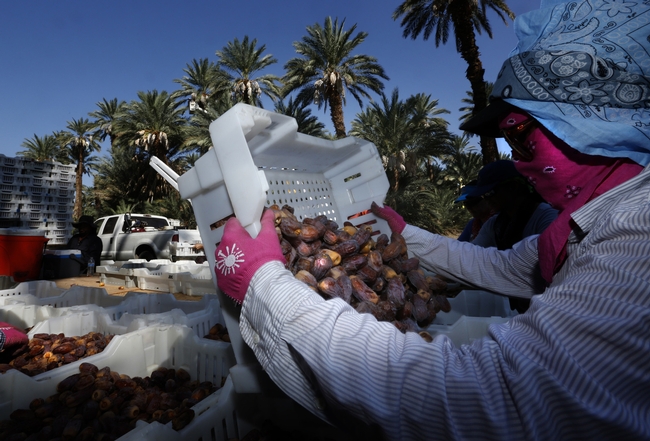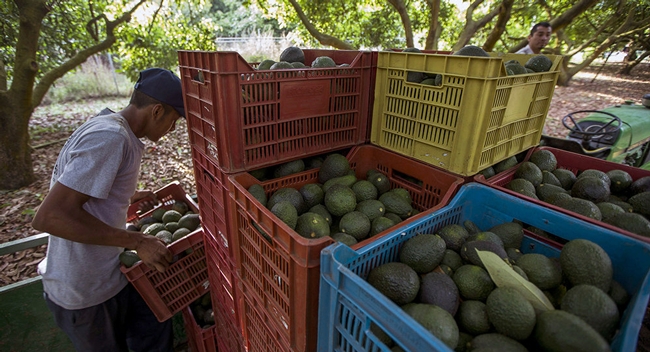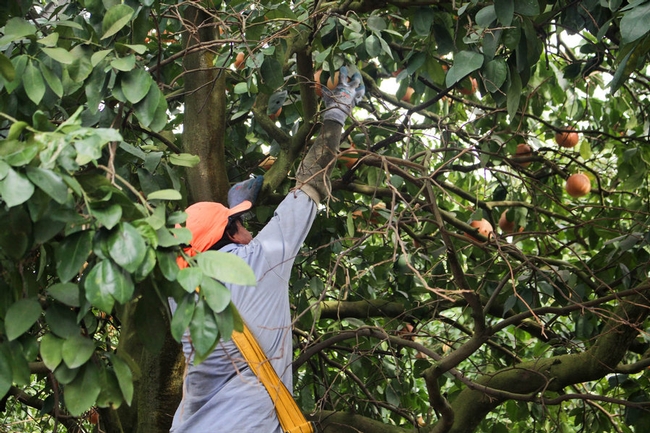
Posts Tagged: workers
Poison Prevention Now and Forever
UC Statewide Integrated Pest Management Program
According to the Centers for Disease Control and Prevention (CDC), poisoning is the number one cause of injury-related death in the United States, and 1073 people in California were poisoned by pesticides in 2014 alone. Each year since 1962, National Poison Prevention Week has taken place during the third week of March, to raise awareness about avoiding these tragedies. No one wants their workers or family members to experience illness or death from pesticide exposure, so the UC IPM Pesticide Safety Education Program (PSEP) would like to bring special attention to preventing pesticide poisoning this week. The program also published a new edition of The Safe and Effective Use of Pesticidesin 2016, which contains a wealth of pesticide safety and hazard prevention information for people who work with pesticides.
Both agricultural and household pesticides can poison people if they are not properly handled. In agriculture, poisoning most often results from pesticide mixing and loading, and the most harm occurs due to spills, splashes and equipment failure. In the home, many pesticide poisoning incidents involve children swallowing pesticides, including garden products, disinfectant cleaners, or other chemicals used to control pests.
One of the most important things you can do to prevent pesticide poisoning is to follow the instructions on the pesticide label. Labels address critical information about how to use a pesticide safely, including the kind of personal protective equipment (PPE) you should wear to prevent overexposure, how much of the product to apply, the minimum time you must wait to enter the area after applying the pesticide (the restricted entry interval), and the minimum time that must pass between application and harvest (preharvest interval).
Labels also include important signal words such as “Danger,” “Warning,” or “Caution” that indicate how acutely toxic the chemical is to humans, as well as directions to avoid pesticide contamination of sensitive areas such as schools and hospitals. These instructions are meant to protect anyone who is at risk of being exposed to hazardous pesticide residues. It is essential to thoroughly read and understand the pesticide label before working with the pesticide, and to carefully comply with label instructions throughout the process. The UC IPM guide to Understanding Pesticide Labels for Making Proper Applications can help you do this, and is available in both English and Spanish.
If you apply pesticides in or around your home, be sure to store them properly and keep them out of the reach of children. Keep in mind that even mothballs may look like candy to very young children. It is illegal and unsafe to store pesticides in food or drink containers, which can easily fool people into consuming them and being poisoned. According to the California Department of Pesticide Regulation, these mistakes caused 62 incidents of child poisoning from pesticide ingestion in California in 2014, and 47 of those cases involved children under six years of age.
To learn more about poisoning and how to prevent it, consider visiting the following resources:
Center for Disease Control and Prevention Leading Causes of Death Reports
National Poison Prevention Week website
National Pesticide Information Center
UC IPM online course: Proper Pesticide Use to Avoid Illegal Residues

Pestcide safety

pesticide help
Ag labor management seminars offer keys to success in times of labor uncertainty
UC Cooperative Extension will hold workshops in Temecula Feb. 1 and 2 to help California agricultural employers facing many challenges including labor shortages, wage & hour laws, joint liability, worker safety, workers comp insurance, and immigration issues and policies.
“Agricultural employers and managers are better prepared to face uncertainty in labor markets with up-to-date information and strategies for dealing with people management, and legal and regulatory issues,” said Ramiro Lobo, UC Cooperative Extension farm advisor in San Diego County and workshop organizer. Additional program partners are the California Farm Labor Contractor Association, Zenith Insurance Company and Wilson Creek Winery and Vineyards.

“Management and Supervision of Personnel for Agricultural Operations,” will be offered in Spanish on Feb. 2. The program, intended for agricultural employers/managers and first-line supervisors, provides information on effective supervision and management in times of labor shortage, updates on labor laws and regulations, positive and clear communications, and preventing sexual harassment and bullying.
“Properly managing personnel is critical because of the scarcity of labor,” Lobo said. “We will provide strategies to retain employees by making the workplace more attractive.”
Advance registration is available with a credit card at http://ucanr.edu/2017aglaborseminar. Registration for the Feb. 1 workshop is $80 per person before Jan. 20, and $100 after or at the door, if space allows. Registration for the Feb. 2 workshop is $60 per person before Jan. 20, and $80 after or at the door, if space allows. A registration discount is available for participants to attend both events. For both events, registration is $120 before Jan. 20, and $140 after or at the door, if space allows.
For more information visit the event website at http://ucanr.edu/2017farmlaborseminar
7:00 am Registration and Continental Breakfast
7:50 am Welcome, Introductions, Acknowledgments, and Overview
8:00 am A Review of Labor Management Issues in Southern California – Panel Discussion
Mike Mellano, Mellano and Company ? Greg Pennyroyal, Wilson Creek Winery & Winery ? Eric Larson, San Diego County Farm Bureau
9:00 am Wage & Hour, Labor Laws Update: Tony Raimondo, Raimondo & Associates
10:00 am BREAK
10:30 am Managing Joint Liability under AB 1897 - Bryan Little, California Farm Bureau Federation, Farm Employer Labor Service
11:15 am The Basics for Legal and Effective Hiring & Orientation for Agricultural Labor - Lupe Sandoval - California Farm Labor Contractor Association
12:00 noon LUNCH
1:00 pm Effective Management of Work Injuries - Chris Boehme, Zenith Insurance Company
1:45 pm Keeping Workers Safe, and Cal OSHA Happy - Bill Krycia, Cal OSHA
2:30 pm BREAK
2:45 pm Selection and Development of Front-Line Supervisors - Lupe Sandoval, California Farm Labor Contractor Association
3:30 pm The H2A Visa Program & What You Need to Know - Jeanne M. Malitz, Malitz Law, Inc.
4:15 pm Labor Shortages – Assorted Strategies – Jeanne Malitz, Malitz Law, Inc., Lupe Sandoval, California Farm Labor Contractor Association and Ramiro Lobo, UCCE San Diego County
5:00 pm Conference Evaluation, Adjourn to Optional Wine Tasting hosted by Wilson Creek Winery and Vineyards!!
2017 FarmLaborSeminar Agenda
Heat Stress
Lettuce harvest
Cal/OSHA HEAT ADVISORY
When employees work in hot conditions, employers must take special precautions in order to prevent heat illness. Heat illness can progress to heat stroke and be fatal, especially when emergency treatment is delayed. An effective approach to heat illness is vital to protecting the lives of California workers.
California law requires employers to identify and evaluate workplace hazards and take the steps necessary to address them. The risk of heat illness can be significantly reduced by consistently following just a few simple steps. Employers of outdoor workers at temporary work locations must be particularly alert and also plan for providing first aid and emergency medical services should they become necessary. All workers should be accounted for during and at the end of the work shift. Heat illness results from a combination of factors including environmental temperature and humidity, direct radiant heat from the sun or other sources, air speed, and workload. Personal factors, such as age, weight, level of fitness, medical condition, use of medications and alcohol, and acclimatization effect how well the body deals with excess heat.
Heat Illness Risk Reduction
1. Recognize the Hazard. There is no absolute cut-off below which work in heat is not a risk. With heavy work at high relative humidity or if workers are wearing protective clothing, even work at 70oF can present a risk. In the relative humidity levels often found in hot areas of California (20 to 40 percent) employers need to take some actions to effectively reduce heat illness risk when temperatures approach 80 F. At temperatures above 90 F, especially with heavy work, heat risk reduction needs to be a major concern.
2. Water. There must be an adequate supply of clean, cool, potable water. Employees who are working in the heat need to drink 3-4 glasses of water per hour, including at the start of the shift, in order to replace the water lost to sweat. For an eight-hour day this means employers must provide two or more gallons per person. Thirst is an unreliable indicator of dehydration. Employees often need ongoing encouragement to consume adequate fluids, especially when the workload or process does not encourage breaks.
3. Shade. The direct heat of the sun can add as much as 15 degrees to the heat index. If possible, work should
be performed in the shade. If not, employers where possible, should provide a shaded area for breaks and when employees need relief from the sun. Wide brimmed hats can also decrease the impact of direct heat.
- Acclimatization. People need time for their bodies to adjust to working in heat. This “acclimatization” is particularly important for employees returning to work after (1) a prolonged absence, (2) recent illness, or (3) recently moving from a cool to a hot climate. For heavy work under very hot conditions, a period of 4 to 10 days of progressively increasing work time starting with about 2 hours work per day under the working conditions is recommended. For less severe conditions at least the first 2 or 3 days of work in the heat should be limited to 2 to 4 hours. Monitor employees closely for signs and symptoms of heat illness, particularly when they have not been working in heat for the last few days, and when a heat wave occurs.
- Rest Breaks. Rest breaks are important to reduce internal heat load and provide time for cooling. Heat illness occurs due to a combination of environmental and internal heat that cannot be adequately dissipated. Breaks should be taken in cooler, shaded areas. Rest breaks also provide an opportunity to drink water.
- Prompt Medical Attention. Recognizing the symptoms of heat illness and providing an effective response requires promptly acting on early warning signs. Common early symptoms and signs of heat illness include headache, muscle cramps, and unusual fatigue. However, progression to more serious illness can be rapid and can include unusual behavior, nausea/vomiting, weakness, rapid pulse excessive sweating or hot dry skin, seizures, and fainting or loss of consciousness. Any of these symptoms require immediate attention.
Even the initial symptoms may indicate serious heat exposure. If medical personnel are not immediately available on-site, and you suspect severe heat illness, you must call 911.
Regardless of the worker's protests, no employee with any of the symptoms of possible serious heat illness noted above should be sent home or left unattended without medical assessment and authorization.
7. Training. Supervisors and employees must be trained in the risks of heat illness, and the measures to protect themselves and their co-workers. Training should include:
- Why it is important to prevent heat illness
- Procedures for acclimatization
- The need to drink approximately one quart per hour of water to replace fluids.
- The need to take breaks out of the heat
- How to recognize the symptoms of heat illness
- How to contact emergency services, and how to effectively report the work location to 911.


